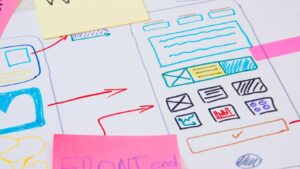 When it comes to creating a successful mobile application, the user interface (UI) design plays a crucial role in engaging users and enhancing their overall experience. A well-crafted UI design not only attracts users but also guides them seamlessly through the app’s functionalities. From intuitive navigation to visually appealing layouts, every aspect of the UI design contributes to the app’s usability and aesthetic appeal. In the competitive landscape of mobile apps, standing out with a unique and user-friendly UI design is essential for capturing and retaining users’ attention. By incorporating practices in UI Design, developers can create interfaces that are not only visually stunning but also highly functional. Understanding the principles of effective UI design is key to crafting apps that resonate with users and keep them coming back for more.
When it comes to creating a successful mobile application, the user interface (UI) design plays a crucial role in engaging users and enhancing their overall experience. A well-crafted UI design not only attracts users but also guides them seamlessly through the app’s functionalities. From intuitive navigation to visually appealing layouts, every aspect of the UI design contributes to the app’s usability and aesthetic appeal. In the competitive landscape of mobile apps, standing out with a unique and user-friendly UI design is essential for capturing and retaining users’ attention. By incorporating practices in UI Design, developers can create interfaces that are not only visually stunning but also highly functional. Understanding the principles of effective UI design is key to crafting apps that resonate with users and keep them coming back for more.
App UI Design
 User Interface (UI) design plays a critical role in the success of mobile applications. A well-crafted UI design is essential for engaging users, improving their experience, and seamlessly guiding them through the functionalities of the app. Emphasizing intuitive navigation, visually appealing layouts, and implementing industry practices are key elements in creating standout UI designs within the competitive mobile app market. Understanding effective UI design principles is crucial for developing interfaces that are not only visually captivating but also highly functional, contributing to enhanced user retention and satisfaction.
User Interface (UI) design plays a critical role in the success of mobile applications. A well-crafted UI design is essential for engaging users, improving their experience, and seamlessly guiding them through the functionalities of the app. Emphasizing intuitive navigation, visually appealing layouts, and implementing industry practices are key elements in creating standout UI designs within the competitive mobile app market. Understanding effective UI design principles is crucial for developing interfaces that are not only visually captivating but also highly functional, contributing to enhanced user retention and satisfaction.
Aesthetics in UI Design are more than just visual appeal; they are a fundamental aspect of user engagement. The choice of colors, typography, icons, and overall visual elements significantly impacts how users perceive and interact with an application. By carefully selecting a cohesive color palette, using legible fonts, and incorporating visually pleasing graphics, designers can create an aesthetically pleasing UI that enhances the overall user experience. A balanced combination of aesthetics and functionality can make an app visually appealing while ensuring its usability and ease of navigation.
Functionality Through Design
Functionality is at the core of effective UI design. Designers must prioritize user interactions, seamless navigation, and accessibility when creating app interfaces. By focusing on user-centered design principles, such as clear information hierarchy, interactive elements, and intuitive layouts, designers can ensure that the app not only looks good but also functions efficiently. Integrating functionality into the design process from the outset allows for the creation of user-friendly interfaces that provide a frictionless experience for app users.
In the ever-evolving landscape of UI Design, keeping up with the latest trends is crucial for creating engaging and user-friendly interfaces. This section explores some of the contemporary trends that are shaping the world of UI Design.
Examples of Excellent UI Design
 Successful apps serve as valuable case studies, showcasing exemplary UI design practices that have contributed to their popularity and user satisfaction. Learning from these success stories provides valuable insights for designing engaging and user-friendly interfaces in the competitive app market.
Successful apps serve as valuable case studies, showcasing exemplary UI design practices that have contributed to their popularity and user satisfaction. Learning from these success stories provides valuable insights for designing engaging and user-friendly interfaces in the competitive app market.
- Instagram: Instagram’s UI design is renowned for its simplicity and intuitive layout. With a focus on visual content, the app’s minimalist design allows users to easily navigate through their feeds, explore new content, and interact with posts seamlessly. The consistent use of color schemes and iconography enhances brand recognition and user experience.
- Airbnb: Airbnb’s UI Design reflects the company’s commitment to providing a personalized and immersive experience for users. The use of high-quality images, clear typography, and interactive elements creates a visually appealing interface that simplifies the booking process and builds trust with users. The app’s seamless navigation and detailed filters enhance usability, ensuring a positive user experience.
- Headspace: The Headspace app stands out for its calming and user-centric UI design, aligning with its meditation and mindfulness focus. The app’s soothing color palette, uncluttered layout, and user-friendly navigation contribute to a tranquil user experience. Features like progress tracking and personalized recommendations further enhance user engagement and satisfaction.
When it comes to designing captivating and user-friendly app interfaces, having the right tools and resources at hand is crucial. UI Designers rely on a variety of software, online tools, communities, and forums to stay updated, collaborate, and enhance their design skills. Here are some essential resources that can aid UI Designers in creating exceptional user interfaces:

